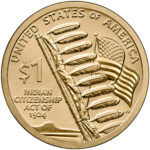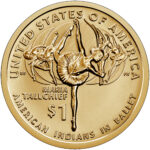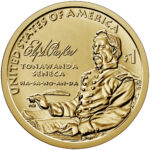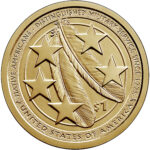In 2009, the U.S. Mint began minting and issuing $1 coins as part of the Native American $1 Coin Program. The coins feature designs recognizing the important contributions made by Native American tribes and individual Native Americans to the history and development of the United States. The Mint issues one new reverse design each year. The program is authorized by the Native American $1 Coin Act (Public Law 110-82).
The program builds on the Sacagawea Golden Dollar, released from 2000 to 2008. The Golden Dollar featured a portrait of Sacagawea carrying her infant son, Jean-Baptiste on the obverse (heads side) and an eagle on the reverse (tails side). It was authorized under Public Law 105-124, also known as the United States $1 Coin Act of 1997 (Section 4 of the 50 States Commemorative Coin Program Act).
Since 2011, Native American $1 coins are circulating quality produced as collectibles, not for everyday transactions. However, they may be still used as legal tender.
Native American $1 Coins
- 2020: Elizabeth Peratrovich
- 2019: American Indians in Space
- 2018: Jim Thorpe
- 2017: Sequoyah
- 2016: Code Talkers
- 2015: Mohawk Ironworkers
- 2014: Native American Hospitality to Lewis & Clark
- 2013: Delaware Treaty of 1778
- 2012: Trade Routes in 17th Century
- 2011: Wampanoag Treaty With Plymouth Bay
- 2010: Great Tree of Peace
- 2009: Three Sisters Agriculture
Design Requirements
The obverse (heads side) design retains the central figure of the “Sacagawea” design first produced in 2000 with the inscriptions “LIBERTY” and “IN GOD WE TRUST.”
The reverse (tails side) design changes each year to honor an important contribution of Indian tribes or individual Native Americans with the inscriptions “$1” and “UNITED STATES OF AMERICA.” The designs are selected by the Secretary of the Treasury after consulting with the U.S. Senate Committee on Indian Affairs, the Congressional Native American Caucus of the U.S. House of Representatives, the Commission of Fine Arts, and the National Congress of American Indians, and after public review by the Citizens Coinage Advisory Committee.
Like Presidential $1 Coins, Native American $1 Coins have a distinctive edge, are golden in color, and feature edge-lettering of the year, mint mark, and “E PLURIBUS UNUM.”
During the years of the program that correspond with the Presidential $1 Coin Program, Native American $1 Coins will be issued, to the maximum extent practicable, in the chronological order in which the Native Americans depicted lived or the events recognized occurred. Following the conclusion of the Presidential $1 Coin Program, the Native American $1 Coin Program coins will be issued in any order determined to be appropriate by the Secretary of the Treasury after consultation with the U.S. Senate Committee on Indian Affairs, the Congressional Native American Caucus of the U.S. House of Representatives, the Commission of Fine Arts, and the National Congress of American Indians, and after public review by the Citizens Coinage Advisory Committee.






